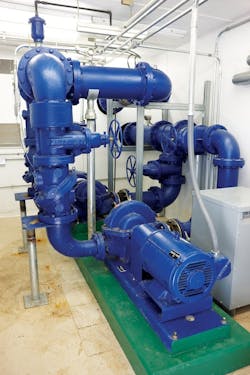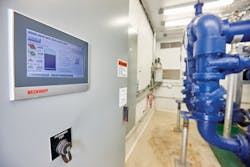About the author:
James Figy is marketing communications specialist for Beckhoff Automation. Figy can
be reached at [email protected] or 952.428.7321.
Throughout history, one of society’s core responsibilities has been to provide clean, running water. In the ancient world, Rome was the most successful at this. The empire’s great aqueducts and indoor plumbing made Roman author Pliny the Elder conclude, “There has never been anything more remarkable in the whole world.”
Of course, we no longer marvel the idea that when we turn on the faucet, clean water will flow. However, Eric Kiefer, plant manager of North Shore Water Commission (NSWC) in Glendale, Wis., knows that providing potable water continues to be an incredible feat even though many people do not give it a second thought.
Approximately 35,000 residents in the cities of Glendale, Fox Point and Whitefish Bay, Wis., rely on this Milwaukee-area municipal entity, which has been pumping clean water since 1963.
“People simply cannot suffer a loss of water pressure,” Kiefer said. “Hospitals, businesses, families—they need this water to always be on the moment they need it.”
The NSWC water purification process begins at Klode Park in Whitefish Bay where an intake structure shaped like a giant straw reaches into Lake Michigan. The pump station sucks raw water through this “straw” and into a pit-like shorewell, while a chemical feed system keeps the intake free of zebra mussels, which can quickly clog the system. Four large pumps in the shorewell send the water through a transmission main to the filtration plant in Glendale. At this time, a coagulant and coagulant aid are added to the water. After passing through a series of flocculators, particulate matter drops out of the solution as the water passes through the sedimentation basins. The clear water from this process flows through a rapid sand filter to remove any remaining sediment left in the water. After the addition of fluoride, water is disinfected with both chlorine and ultraviolet (UV) light. Finally, water is treated with a phosphate chemical to prevent lead and copper corrosion as it is pumped to consumers.
On a typical day, the plant purifies 3.7 million gal of water. However, it has the capability to process 18 million gal per day. It may seem excessive, but if one part of the system broke, the technicians would be able to start a backup right away to ensure no customers lose water.
“You must have redundancy in water treatment,” Kiefer said. “I know that if I had to fill a plant with only the essential things, my plant would be a fifth of the size it is right now. This plant has everything in excess, but by regulation, you need to have extra pumps, filters and valves. You need to have all these redundant parts in the event of a power outage or equipment failure.”
Aging Systems & Tight Budgets
The 55-year-old NSWC plant contains many pieces of legacy equipment that pose minor difficulties when interfacing with today’s automation systems. Larger difficulties have been introduced via automation hardware and software produced by different vendors that must all be programmed to work together. NSWC must continuously collect data to create detailed reports on system pressure, flow, pump speeds, pump runtimes and valve positions at the pumping stations in Glendale, Fox Point and Whitefish Bay, as well as chemical tank levels, pounds of chemical pumped and various water quality parameters. The multi-vendor architecture must not inhibit data collection. However, because the first installations began in the mid-1990s, it does create challenges.
“The facility was not fully automated until the year 2000,” Kiefer said. “Since then, we have tried out multiple brands for the controls technology, but the last wave has been focused on equipment from Beckhoff Automation.”
Whenever there is a system or process upgrade, some water treatment operations might replace all of their supervisory control and data acquisition (SCADA) hardware to avoid communication breakdowns between different makes of machinery. For municipal entities, however, this is not always feasible, as the people in charge of daily operations do not make the final decision.
“In a municipal world, budget is typically constrained by taxpayers or water ratepayers,” Kiefer said. “We would put in new hardware right away and everything would be shiny and new. But if SCADA equipment is still in good operating condition, and there is a tight budget, it won’t get replaced.”
Typically, NSWC must wait until a key piece of equipment becomes unreliable or no longer meets regulations. The risk of not complying with state or federal water quality standards often motivates local taxpayers to fund large upgrade projects. During these large projects, additional automation or general plant-wide upgrades often get lumped into the project’s budget. In 2006, NSWC completed its UV disinfection system and also upgraded its air compressors, transformers, SCADA equipment, controllers, human machine interfaces (HMI), databases and servers.
Along with the compounding pressures for reliable water service and minimal expenses, every project must be successful on a budget. In 2015 when Fox Point decided to upgrade its pump station, Kiefer researched the best automation and control system that would be cost effective, reliable, easy to program and able to communicate with legacy equipment.
Kiefer said that due to pressure from consumers and outside entities, NSWC cannot afford any mistakes.
“We have to be competent and ahead of the game every day,” he said. “Otherwise, private contract firms will come in and say they can do it better, cheaper and faster.”
Installation & Communication
Kiefer learned about Beckhoff through another technology partner and decided the products would provide the most efficient option for the project. In his spare time, he designed, built and programmed the system for Fox Point.
At the pump station, a number of EtherCAT I/O terminals communicate with the on-site machinery and equipment. A 7-in. multi-touch control panel works well in the tight quarters of the shed. This control panel is connected to a fan-less embedded PC with a 1.4 GHz Intel Celeron processor, which runs the compact pump station and transmits all data to the main facility in Glendale.
After building the pumping station control cabinet, Kiefer hired Starnet Technologies, a Caledonia, Wis.-based, company that supports the water and wastewater industries, to draft an electrical schematic to document it. Later, Starnet built an identical control cabinet for an upgrade to Glendale’s pumping station standpipe. The company soon will upgrade the Whitefish Bay standpipe.
“We worked with the data sheets, which were well done, and incorporated them into the drawings and went through our normal documentation process,” said Steven Grindeland, division manager for Starnet Technologies. “It did not present any issues and was seamless in that regard.”
Along with ease of installation and additional hardware benefits, TwinCAT 3 automation software allows Kiefer to see which systems are off or on, and the open PC-based control platform easily allows any add-on software that can run on a PC. Kiefer uses Git, a source management tool that allows programmers to create a complete repository of file versions for each new project. He appreciates not only how well the automation software works with other software platforms, but also how new IoT and analytics packages are designed to use cloud communication protocols, including OPC UA, MQTT and AMQP.
“There will be a communications paradigm shift in the near future, and having Beckhoff puts us in a better position to respond to it,” Kiefer said. “Beckhoff already has available libraries that we can add to utilize those upcoming protocols, so we’re far more prepared for the future by standardizing on TwinCAT 3.”
The pump stations pass encrypted data over OPC UA using the automation software and the embedded PCs to NSWC facilities, and dashboards can display important results via the HMI software. James Redford, president of Redford Data Services, collaborated with NSWC to program a new SCADA system. For the pumping stations, the updated SCADA added greater fault reset capabilities, pump speed control, access via Windows Remote Desktop and more modes of operation. Although Redford was a newcomer to the hardware and software then, he found the systems to be intuitive. It surprised him how well the solutions communicated with other vendors’ products, which frequently is a difficult proposition.
“The Glendale project was the first project I worked on with Beckhoff, and it was an excellent hardware and software platform,” Redford said. “The software offered a wide range of useful programming tools, even though there was an initial learning curve.”
Peace of Mind
The upgraded pumping stations have increased the entire system’s reliability and decreased costs using the SCADA technology. Kiefer realized additional savings in software programming and technical support. Because the TwinCAT 3 engineering environment is free, NSWC did not have to pay the $10,000 that its previous vendor charged for software licensing. In addition, Beckhoff does not require a support contract, which saves NSWC roughly $150 per device each year. According to Kiefer, the direct support services also provided higher value than previously used support channels.
“At Beckhoff, you can immediately reach someone who really collaborates with you and helps answer difficult questions as opposed to somebody who is essentially reading off a script,” Redford said. “That was absolutely never the case with Beckhoff support.”
The NSWC projects also marked the first time Grindeland came into contact with Beckhoff technology. Because public projects in Wisconsin often mandate which brand to use, Starnet rarely has any say in the products its technicians use and, as a result, few opportunities to work with new systems. However, despite the initial lack of familiarity with the products, the build quality and subsequent operation of the PC-based control system has delivered reliable operation.
Along with upgrades to two of its three remote pumping stations, Kiefer used a similar platform to enhance the filtration plant’s chemical feed system, using EtherCAT I/O and an embedded PC with a dual-core Intel Core i7 processor. The plant-wide SCADA update allowed for the chemical feed systems to provide more effective reporting, alarms and troubleshooting. The reliable system architecture throughout the plant and pumping stations ensures that all NSWC customers have always-on, consistent water service and peace of mind.


